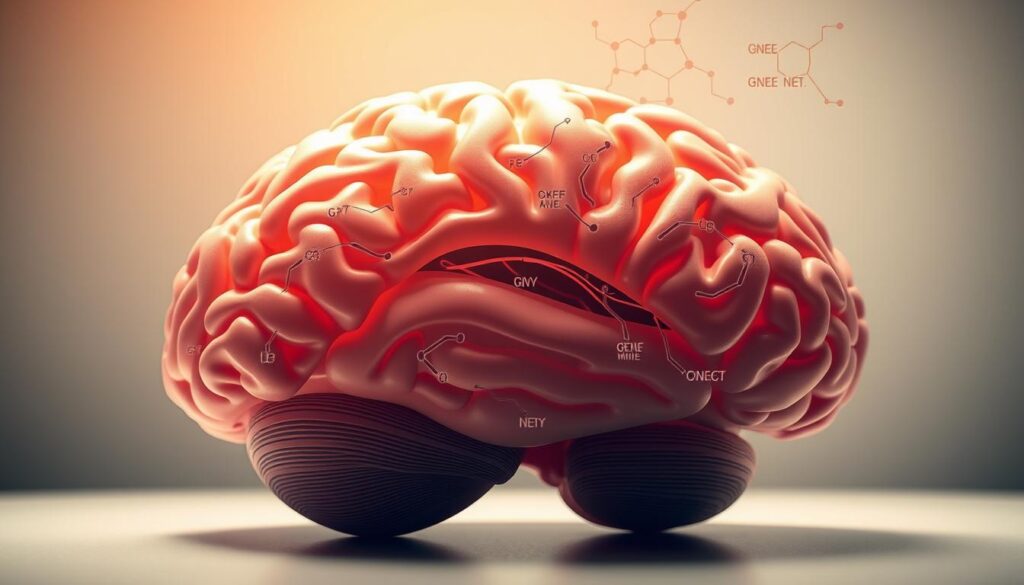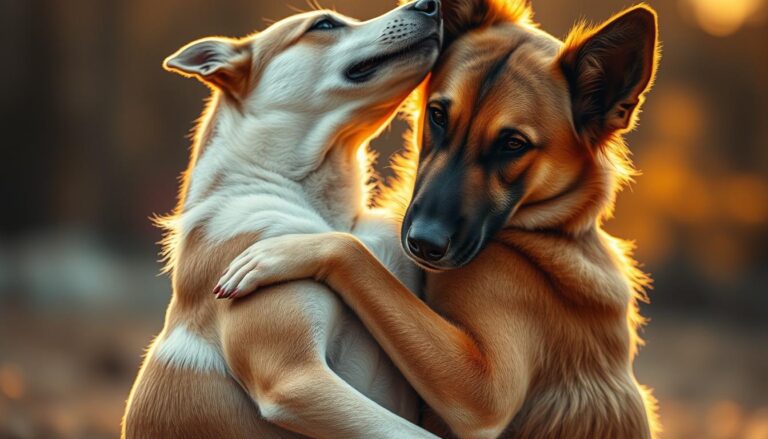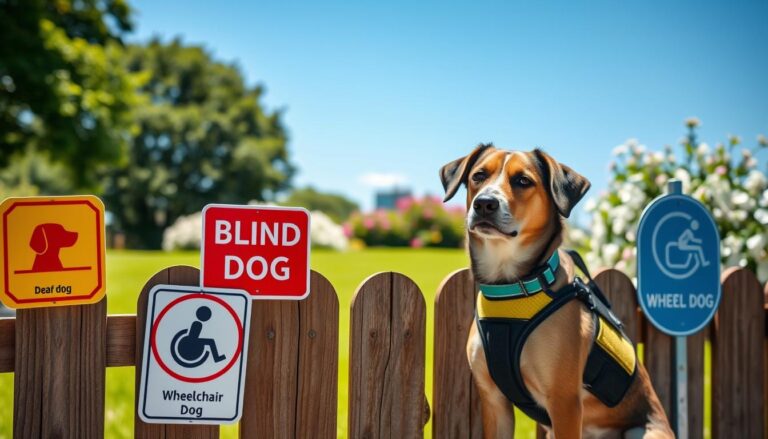Autism in Dogs Symptoms: What Owners Should Know
As a dog owner, you might have noticed your furry friend acting differently. They might struggle with social interactions or show repetitive behaviors. Knowing about autism in dogs can help you support your pet better.
Veterinary science doesn’t officially say dogs have autism. But, some signs can point to Canine Dysfunctional Behavior (CDB). These signs are similar to those in humans with autism spectrum disorder.
Dogs with autism-like symptoms might pull back from social interactions or be very sensitive to their surroundings. Spotting these signs early can greatly improve your dog’s life and your care for them.
This guide will explore the world of autism in dogs. It will help you understand these behaviors and support your dog. Whether you’re facing these challenges or just want to learn, you’ll find helpful insights here.
Table of Contents
Understanding Canine Dysfunctional Behavior (CDB)
Dog owners often see puzzling changes in their pets. Canine Dysfunctional Behavior (CDB) is a complex set of neurological challenges. It goes beyond usual training issues or medical problems.
Defining Unusual Canine Behaviors
CDB includes a range of dog communication issues. These behaviors are different from usual dog interactions. Symptoms can include:
- Extreme social withdrawal
- Repetitive motion patterns
- Intense sensitivity to environmental stimuli
- Resistance to routine changes
Connection to Autism-Like Symptoms
Veterinary researchers have found links between CDB and autism. Dogs with these challenges may have unique neurological processing. This affects their social interactions and communication strategies.
Scientific Research Insights
Studies show that genetics and environment play a role in dog behavior. Behaviorists are looking for neurological markers. This could help us understand these complex conditions better.
Understanding CDB requires patience, professional guidance, and a compassionate approach to your dog’s unique neurological landscape.
Common Autism in Dogs Symptoms
Understanding autism in dogs means watching for certain behaviors. Dogs with autism show unique signs that differ from usual dog behavior. Knowing these signs helps you support your dog and solve social issues.
Social Interaction Difficulties
Dogs with autism often find it hard to connect with others. You might see your dog:
- Avoiding eye contact with humans or other animals
- Showing little interest in playing or interacting
- Preferring to be alone rather than with others
- Feeling anxious when around people or other animals
Communication Challenges
Communication is tough for dogs with autism. They might:
- Not always listen to commands
- Have trouble understanding social signals
- Make few sounds
- Seem distant during talks
Repetitive Behavioral Patterns
Repetitive actions are common in dogs with autism. These can include:
| Behavior Type | Specific Actions |
|---|---|
| Physical Repetitions | Tail chasing, spinning, pacing |
| Sensory Fixations | Obsessive licking, staring at specific objects |
| Routine Rigidity | Extreme resistance to changes in environment |
Understanding these symptoms can help you provide targeted support and create a more comfortable environment for your unique canine companion.
Recognizing Early Warning Signs in Dogs
Knowing the early signs of canine autism can help you spot changes in your dog’s behavior early. Dog owners need to watch for small changes in how their pets act.
Spotting changes in a dog’s behavior takes careful watching and keeping a record. Some signs might mean your dog is showing autism-like traits:
- Reduced physical activity or lethargy
- Unusual reactions to sensory stimuli
- Minimal social interaction with humans or other animals
- Repetitive movements or behaviors
- Extreme sensitivity to touch or sound
Some specific signs that might mean your dog has autism include:
| Behavioral Aspect | Potential Warning Sign |
|---|---|
| Social Interaction | Avoiding eye contact, limited response to name |
| Sensory Processing | Overreacting to minor sounds or touches |
| Motor Skills | Unusual walking patterns or repetitive movements |
“Early detection of behavioral changes can significantly improve management strategies for dogs experiencing autism-like symptoms.” – Veterinary Behavioral Specialists
If you see many of these signs often, talk to a vet behaviorist. They can give a detailed check-up and advice that fits your dog’s needs.
Remember, not all changes in behavior mean autism. Getting a vet’s opinion is key to understanding your dog’s brain.
The Role of Genetics and Environmental Factors
Understanding autism in dogs requires looking at genetics and environment. Dogs, like humans, can have unique behaviors. These are shaped by many factors that affect their brain and senses.

Genetics are key in shaping a dog’s behavior. Some breeds are more likely to show autism-like traits. This is because of their inherited brain characteristics.
Breed-Specific Behavioral Tendencies
- Herding breeds may show increased sensory sensitivities
- Working dogs often display more pronounced repetitive behaviors
- Some toy breeds demonstrate higher rates of social interaction challenges
Environmental Triggers
Early life experiences greatly affect a dog’s behavior. Traumatic events, bad socialization, and stress can lead to autism-like symptoms in dogs.
Impact of Early Development
The first few months of a puppy’s life are vital. Good food, gentle care, and positive social interactions can help prevent behavioral issues. This is especially true for autism in dogs.
Recognizing and addressing these factors early can dramatically improve a dog’s quality of life and behavioral adaptation.
Knowing about genetics and environment can help you support dogs with unique behaviors. This support is crucial for their well-being.
Diagnostic Process and Professional Assessment
Diagnosing autism in dogs is a detailed and careful process. Veterinarians know that changes in behavior can come from many sources. This makes finding the cause complex and detailed.
If you think your dog might have autism-like behaviors, a professional will assess them. This involves several important steps:
- Detailed behavioral history collection
- Comprehensive physical examination
- Neurological screening
- Behavioral observation periods
- Potential genetic testing
Veterinary behaviorists are key in diagnosing canine dysfunctional behavior (CDB). They use special techniques to tell normal variations from concerning behaviors.
Your vet will look closely at several things during the diagnosis:
- Social interaction patterns
- Communication challenges
- Repetitive behavioral traits
- Sensory processing responses
It’s important to understand that true autism cannot be definitively diagnosed in dogs. Instead, professionals focus on identifying and managing specific behavioral changes that might indicate underlying neurological differences.
Professional assessment is key to understanding and supporting your dog’s unique behavioral needs.
Your vet might suggest more tests like behavioral questionnaires and extended observation. They also check for other medical conditions that could look like autism.
Treatment Options and Management Strategies
Managing autism-like symptoms in dogs needs a caring and detailed plan. Your vet can help create a strategy that meets your dog’s special needs. This can help lessen anxiety in autistic dogs.
It’s important to understand the challenges of repetitive behaviors in dogs. Each dog needs a plan that fits their unique symptoms and triggers.
Behavioral Modification Techniques
Good behavioral interventions aim to make experiences positive and reduce stress. Key strategies include:
- Desensitization to specific triggers
- Counterconditioning through positive reinforcement
- Gradual exposure to challenging stimuli
- Reward-based training methods
Environmental Adjustments
Creating a structured and predictable environment helps dogs with autism-like symptoms. Consider these adjustments:
- Establish consistent daily routines
- Create calm, quiet spaces
- Minimize sudden environmental changes
- Use calming sensory tools
Professional Support Systems
Getting professional help is key in managing your dog’s unique challenges. Veterinary behaviorists can offer specialized assessments and tailored plans.
Expert support transforms challenges into opportunities for growth and understanding.
Working together with vets, trainers, and behavior specialists helps create a comprehensive plan. This plan addresses your dog’s specific needs.
Living with an Autistic Dog: Daily Challenges and Solutions
Caring for a dog with autism needs patience, understanding, and special strategies. Your dog might face unique social problems that need careful daily handling.
To manage well, create a structured and supportive home. Dogs with autism do best when their routines are set and easy to follow.
- Establish a calm, quiet living space
- Minimize unexpected changes in daily routine
- Use gentle, predictable communication methods
- Create safe spaces for your dog to retreat
Socialization can be tough. Your dog might find it hard to:
- Interact with other animals
- Understand human social cues
- Deal with too much sensory input
Getting help from a vet behaviorist can really help. They can give you specific ways to help your dog with social issues and anxiety.
Every dog is different, and what works for one might not work for another. Being patient and kind is the most important thing.
Living with a dog with autism is a journey of love and understanding. Your dedication can make your dog’s life happy and comfortable.
Creating a Supportive Environment for Dogs with Autism-Like Symptoms

Managing sensory sensitivities in dogs needs careful planning and understanding. Your dog with canine autism signs needs a special living space. This space should reduce stress and meet their unique needs.
Creating a supportive home involves several key strategies:
- Establish a consistent daily routine
- Design quiet retreat spaces
- Minimize sudden environmental changes
- Use calming techniques
Dogs with sensory sensitivities often do well in structured environments. These places offer predictability and comfort. Think about making special zones in your home that provide:
- Quiet corners for relaxation
- Reduced visual stimulation
- Controlled noise levels
Interactive enrichment can help manage canine autism signs. Use puzzle toys, controlled sensory experiences, and gentle training methods. These can stimulate your dog’s mind without overwhelming them.
| Environmental Strategy | Benefit |
|---|---|
| Consistent Routine | Reduces Anxiety |
| Quiet Retreat Spaces | Provides Emotional Safety |
| Sensory-Friendly Toys | Mental Stimulation |
Remember, patience and understanding are key when supporting a dog with unique needs. Every small change can make a big difference in their life.
Conclusion
Spotting autism in dogs needs careful watching and expert advice. Dealing with a dog’s communication problems can be tough. But, knowing their special ways is key to caring for them well.
Studies keep looking into dog behavior, showing the need for custom plans. Even without a cure, the right steps can make your dog’s life better. Experts in vet behavior can craft plans that fit your dog’s needs and reduce stress.
Every dog is different, and being patient is essential. By making a supportive space, changing behaviors, and talking to vet experts, you can help your dog. This way, they can handle their special needs better.
The study of dog behavior is getting better. More research and awareness mean better help for dog owners. Keep learning, be kind, and your care can greatly improve your dog’s life.







